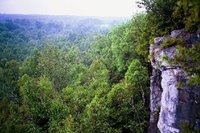Niagara Escarpment
|
|

The Niagara Escarpment is a long escarpment or cuesta running through Ontario in Canada, New York State, Wisconsin, Michigan, and Illinois in the United States. It is composed of the Lockport geological formation of Silurian age, and is similar to the Onondaga geological formation, which runs parallel to it and just to the south, in New York and eastern Ontario. The escarpment is most famous for and named after the cliff over which the Niagara River forms Niagara Falls.
Approximate_area_of_the_Niagara_Escarpment_2.PNG
The Niagara Escarpment is the most prominent of several escarpments formed in the bedrock of southern Ontario. It is traceable starting in eastern New York and along a westerly direction across the Niagara River into Ontario where it stretches along the Niagara Peninsula and northerly to Georgian Bay near Collingwood. It then turns westerly toward Owen Sound at which point it turns northerly to form the spine of the Bruce Peninsula, the Manitoulin and other islands located in northern Lake Huron where it turns westerly into the Upper Peninsula of northern Michigan. It then extends southward from the area of Sault Ste. Marie into Wisconsin following the Door Peninsula and western coast of Lake Michigan, ending near Chicago.
Formation
Study of rock exposures and drillholes demonstrates that there is no displacement of the rock layers at the Escarpment: this is not a fault line but the result of unequal erosion. The Niagara Escarpment has a caprock of dolomitic limestone ("dolostone") which is more resistant and overlies weaker, more easily eroded shale as a weathering-resistant "cap". In other words, the escarpment formed over millions of years through a process of differential erosion of rocks of different hardnesses. Through time the soft rocks weather away or erode by the action of streams. The gradual removal of the soft rocks undercuts the resistant caprock, leaving a cliff or escarpment. The erosional process is most readily seen at Niagara Falls, where the river has quickened the process. It can also be seen on the three waterfalls of the Genesee River at Rochester, New York. Additional resistant rock layers make more than one escarpment in some places. Also, in some places thick glacial deposits conceal the Niagara Escarpment, such as north of Georgetown, Ontario, where it actually continues under glacial till and reappears farther north.
The dolostone cap was laid down as sediment on the floor of a marine environment. In Michigan, behind the Escarpment, the cuesta capstone slopes gently to form a wide basin, the floor of an Ordovician-Silurian tropical sea. There the constant depositing of minute shells and fragments of biologically-generated calcium carbonate, mixed with sediment washing in by erosion of the virtually lifeless landmasses eventually formed a limestone layer. In the Silurian some magnesium substituted for some of the calcium in the carbonates, slowly forming harder sedimentary strata in the same fashion. Worldwide sea levels were at their all-time maximum in the Ordovician; as the sea retreated, erosion inevitably began.
- Steven Dutch (University of Wisconsin),"The Niagara Escarpment" (http://www.uwgb.edu/dutchs/geolwisc/niagesc.htm)
World Biosphere Reserve
In February 1990, the Niagara Escarpment was designated a World Biosphere Reserve by UNESCO, making it one of 12 in Canada. Development and land use adjacent to the escarpment is regulated and the biosphere protected by the Niagara Escarpment Commission, an agency of the Ontario government.
Niagara Falls is formed by the Niagara River flowing over the height of land created by the escarpment. By the process of erosion the falls have retreated upstream 10 km (6 mi.) from the face of the escarpment forming the Niagara Gorge. The Bruce Trail runs the length of the escarpment from Queenston to Tobermory.
The Welland Canal allows ships to traverse the Escarpment between Lake Erie and Lake Ontario. The escarpment was a major obstacle in the contruction of the Erie Canal in New York and was traversed by a series of locks at a community which thus became known as Lockport.
External links
- Niagara Escarpment Commission (http://www.escarpment.org/)
- Escarpment Coalition (http://www.niagaraescarpment.org/)
- Escarpment Interprative Centre (http://www.escarpmentcentre.org/)
- Lockport formation diagrams and rocks (http://www.lockport-ny.com/Museum/rocks.htm)
- Wisconsin Geology Page- Niagara Escarpment (http://www.uwgb.edu/dutchs/geolwisc/niagesc.htm)

